
| Genus List | Species List | Pyramica Overview |
Bolton, B. 2000. The ant tribe Dacetini, with a revision of the Strumigenys species of the Malagasy Region by Brian L. Fisher, and a revision of the Austral epopostrumiform genera by Steven O. Shattuck. Memoirs of the American Entomological Institute 65:1-1028.
Measurements and indices used in the key and reported in some species accounts are:
HL: head length, measured in full-face view, from line tangent to posterior vertex lobes to line tangent to anteriormost point or points of head capsule (see figure).
HW: head width, measured in full-face view, across widest portion of head capsule above level of eyes.
ML: mandible length, measured in full-face view, from anteriormost point or points of head capsule to tip of closed mandibles (see figure).
THL: total head length = HL + ML.
SL: scape length.
CI: HW/HL (x 100).
MI: ML/HL (x 100).
SI: SL/HW (x 100).
Old key to Smithistruma.
Old key to Neostruma.
Old key to Glamyromyrmex.
10a. Mandibles in full-face view sublinear to linear, elongate and narrow; at full closure engaging only in the apical halves or less of their lengths; either with an elongate space between the mandibles or their inner margins convex so that the margins touch, or nearly touch, near the midlength: 20
10b. Mandibles in full-face view either short and stoutly trap-like, or triangular to elongate-triangular; at full closure engaging through most or all of their exposed length, without a space between the mandibles or at most with a small space basally: 100

20a. Ventral surface of petiole with a strip or curtain of spongiform tissue; leading edge of scape without freely projecting broadly spatulate or spoon-shaped hairs: 30
20b. Ventral surface of petiole usually without spongiform tissue; leading edge of scape with freely projecting spatulate to spoon-shaped hairs: 400

30a. Mandible with long toothless shaft, with teeth mainly at apex; face lacking appressed spatulate hairs: warditeras
30b. Mandible with a series of small teeth along most of inner border; face with abundant appressed spatulate hairs: JTL-012
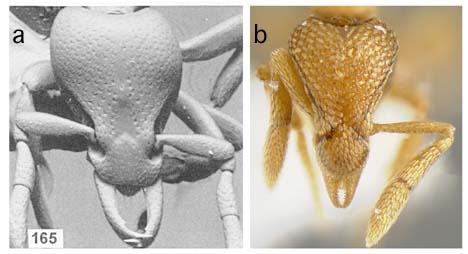
100a. With head in full-face view the leading edge of the scape with a row of conspicuous projecting curved hairs, of which one or more, distal to the subbasal bend, distinctly curves toward the base of the scape: 110
100b. With the head in full-face view the leading edge of the scape lacking projecting hairs that distinctly curve toward the base of the scape; scape edge may have elongate simple straight or flagellate projecting hairs present; or may have entirely anteriorly or apically directed short hairs; or the edge may be hairless: 250

110a. Pronotal humeral hair present, may be filiform, flagellate, remiform or clavate; humeral hair always distinctly differentiated from any other pilosity that may be present on the dorsal pronotum: 120
110b. Pronotal humeral hair absent; humerus without a hair that is distinctly differentiated from any other pilosity that may be present on the dorsal pronotum: 200

120a. Ventral surface of petiole in profile with spongiform tissue absent; disc of postpetiole reticulate-punctate: schulzi
120b. Ventral surface of petiole in profile with a deep, conspicuous and very obviously spongiform curtain, its maximum depth at least half that of the peduncle and usually more; disc of postpetiole completely unsculptured and glassy smooth: 130
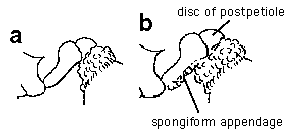
130a. Anterior border of clypeus relatively more V-shaped; basal lamella of mandible followed distally by a long edentate second lamella that extends forward about half the exposed length of the fully closed mandible, the two separated only by a minute cleft; mandibles relatively long, MI 27-33: alberti
130b. Anterior border of clypeus more broadly rounded; basal lamella of mandible immediately followed distally by the tooth-row, without a second lamella that extends forward for half the exposed length of the fully closed mandible; mandibles shorter, MI 19-24: 140
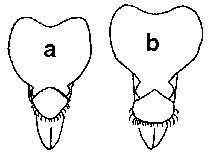
140a. Eyes small, with only four ommatidia in total; promesonotal dorsum without a median longitudinal carina; pronotal dorsum entirely smooth and shining; propodeal dorsum smooth and shining; in full-face view anterior clypeal margin narrowly convex between points where outer margins of fully closed mandibles intersect the clypeal margin: parsauga
140b. Eye larger, with ten or more ommatidia in total; promesonotal dorsum with a fine median longitudinal carina through most or all of its length; pronotal dorsum partially to mostly sculptured; propodeal dorsum weakly to strongly reticulate-punctate; in full-face view anterior clypeal margin transverse to extremely shallowly convex between points where outer margins of fully closed mandibles intersect the clypeal margin: 150

150a. Basal tooth-row of mandible consisting only of narrowly triangular high acute teeth; disc of petiole node in dorsal view as long as broad and with the sides of the node converging anteriorly: fridericimuelleri
150b. Basal tooth-row of mandible consisting of alternating high narrow acutely triangular teeth and lower bluntly rounded broader teeth; tooth four from base particularly broad and rounded; disc of petiole node in dorsal view much broader than long, roughly transversely rectangular, the sides not converging anteriorly: nigrescens

200a. Head in profile strongly dorsoventrally flattened; dorsal surfaces of middle and hind tibiae with abundant freely projecting suberect to erect simple hairs: depressiceps
200b. Head in profile not strongly dorsoventrally flattened; dorsal surfaces of middle and hind tibiae with decumbent to appressed short spatulate hairs only: 210
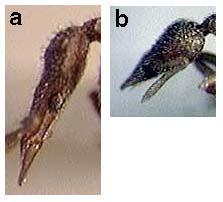
210a. Mandible relatively short and curved downward; dorsal mesosoma smooth or nearly so; pronotum sharply marginate anteriorly, marginate dorsolaterally throughout its entire length; with the head in full-face view and the mandibles fully closed the dorsal surface of each mandible basally with a very distinct sharp transverse edge or rim that extends across the width of the blade, parallel to and in front of the anterior clypeal margin: membranifera
210b. Mandible relatively longer, not curved downward; dorsal mesosoma reticulate-punctate; pronotum not marginate anteriorly nor dorsolaterally; with the head in full-face view and the mandibles fully closed the dorsal surface of each mandible entire basally, without a transverse edge or rim: 220

220a. First gastral tergite finely and densely striolate-punctulate or striolate-costulate everywhere; basigastral costulae minute and inconspicuous, restricted to extreme base of tergite and masked by the other dense sculpture; infradental lamella of propodeum not developed; disc of postpetiole sculptured: margaritae
220b. First gastral tergite smooth behind the basigastral costulae, the latter distinct and extending at least the basal fifth to quarter of the length of the tergite, not masked by dense sculpture; infradental lamella of propodeum strongly developed; disc of postpetiole smooth: epinotalis

250a. Propodeum unarmed, although with a lamella extending up posterior face; face smooth and shining; color orange: paradoxa
250b. Propodeum with acute spines; face smooth to punctate; color orange to black: 260
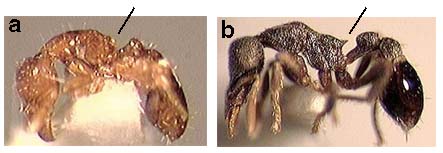
260a. Lateral head capsule with the antennal scrobe entirely reticulate or reticulate-punctate; face lacking smooth areas; mandible relatively straight in profile: 270
260b. Lateral head capsule with the antennal scrobe mostly or entirely smooth and shining; face often partially to entirely smooth and shining; mandible curving downward in profile (former Glamyromyrmex): 310
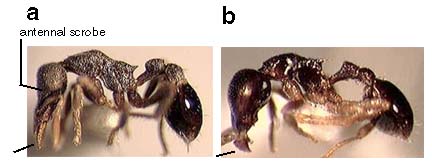
270a. Head long and narrow, CI 55-61: probatrix
270b. Head relatively broader, CI 77-83: 280
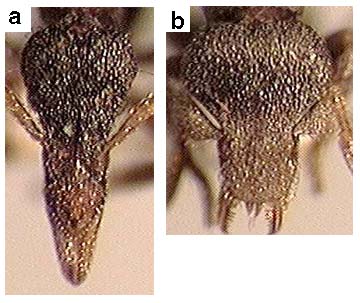
280a. In side view, face distinctly bristly, with numerous short erect setae: 300
280b. Face lacking erect setae or with extremely inconspicous, short, subdecumbent setae: microthrix
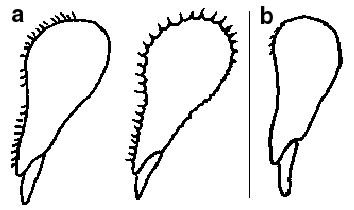
300a. Surface of face granular but not tuberculate; cephalic dorsum at level of frontal lobes without a transverse row of hairs that are much longer than the surrounding pilosity; promesonotal dorsum lacking abundant short stubbly hairs: cassicuspis
300b. Surface of face granular and roughly tuberculate; cephalic dorsum at level of frontal lobes with a transverse row of four hairs that are much longer than the surrounding short pilosity; promesonotal dorsum with abundant short stubbly hairs similar to those on face: stauroma
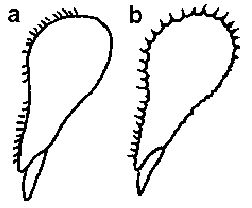
310a. Disc of postpetiole in dorsal view not U-shaped or V-shaped, without a deeply concave anterior face; spongiform tissue present on ventral surface of postpetiole: wheeleri
310b. Disc of postpetiole in dorsal view very broadly U-shaped or V-shaped, with an extremely deeply concave anterior face; spongiform tissue absent from ventral surface of petiole, postpetiole and first gastral sternite: 320
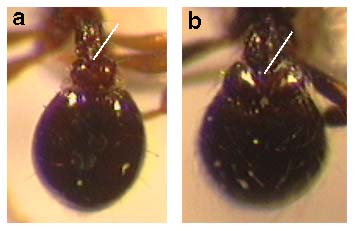
320a. Face and/or sides of head with suberect to erect setae: 330
320b. Face and vertex completely lacking erect setae: 340

330a. Mesosoma strongly ankylosed, dorsal face of propodeum not at all differentiated from posterior face, the continuous surface long flat shiny, meeting promesonotal dorsum at a sharp transverse carina; setae on face sparse, straight, restricted to sides of head and posterior head near vertex margin: erikae
330b. Mesosoma more elongate, with dorsal and posterior faces of propodeum more differentiated; face pilosity variable: 331

331a. Gaster in lateral view tear drop shaped, strongly concave anteriorly near insertion of postpetiole; face with pilosity sparse, fewer than 20 subdecumbent to erect setae: 332
331b. Gaster in lateral view relatively elliptical, not strongly concave near postpetiolar insertion; face with pilosity abundant, more than 20 subdecumbent to erect setae: 335
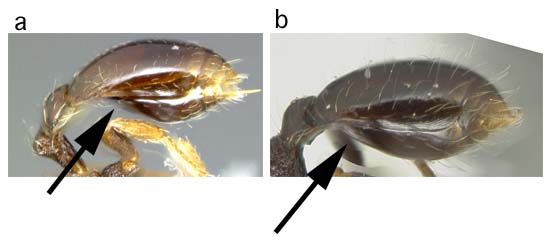
332a. Pilosity on face very sparse, restricted to four or fewer erect setae near posterior margin of face; petiolar node in dorsal view about as wide as long: rogata
332b. Pilosity on face more abundant, about 8 erect setae near posterior margin of face and a few erect setae projecting from sides of head; petiolar node in dorsal view wider than long: turpis
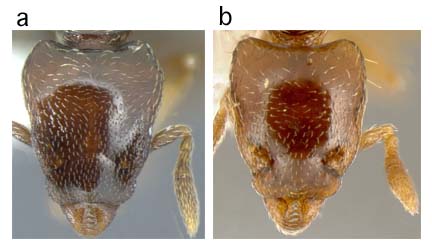
335a. Face largely smooth and shining, with coarse rugose sculpture restricted to margin near frontal carinae; setae on face short and suberect to subdecumbent: dontopagis
335b. Face coarsely rugose over disk, except for narrow median smooth area; setae on face and mesosoma long, abundant, and erect: excisa
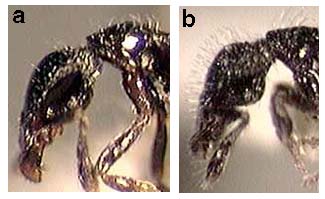
340a. Head in side view extremely flattened; pronotal humeral hair absent: longinoi
340b. Head in side view convex above and below, not flattened; pronotal humeral hair present or absent: 350

350a. Pronotum in dorsal view more elongate, anterior margin more convex, rounding into lateral margins; pronotal humeral hair absent; dorsum of petiolar node strongly reticulate rugose; gaster in lateral view relatively elliptical, not strongly concave near postpetiolar insertion: augustandrewi
350b. Pronotum in dorsal view less elongate, anterior margin more shallowly convex, meeting lateral margins at more distinct angle; pronotal humeral hair present; dorsum of petiolar node smooth and shining; gaster in lateral view tear drop shaped, strongly concave anteriorly near insertion of postpetiole: rogata
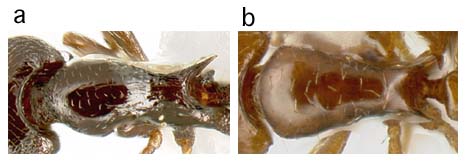
400a. Inner margin of mandible with a clearly defined submedian tooth or distinctly enlarged denticle at or just distal of the midlength, this tooth or denticle obviously larger than any other preapical dentition that may be present distal to it; labral lobes long to very long, trigger hairs at apices of lobes short; in ventral view (usually also visible in profile) the trigger hairs at most subequal in length to the lobes, usually obviously shorter (former Neostruma): 410
400b. Inner margin of mandible without a tooth or distinctly enlarged denticle at or near the midlength that is obviously larger than any other preapical dentition that may be present distal to it; labral lobes short or very short, trigger hairs at apices of lobes long; in ventral view (usually also visible in profile) the trigger hairs longer than the lobes (species formerly placed in Strumigenys): 500
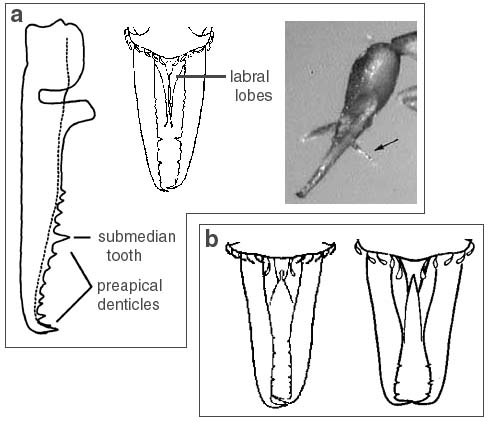
410a. Middle preapical denticle distinctly larger than flanking denticles, similar in size to submedian tooth; mandibles relatively long (MI 61-67); mesosomal dorsum evenly convex, propodeal suture not impressed; total head length greater than 0.90mm: myllorhapha
410b. Preapical denticles all of similar size or gradually decreasing in size; mandibles relatively shorter (MI 33-45); mesosomal dorsum flatter, propodeal suture moderately impressed; head length variable but usually smaller: 420
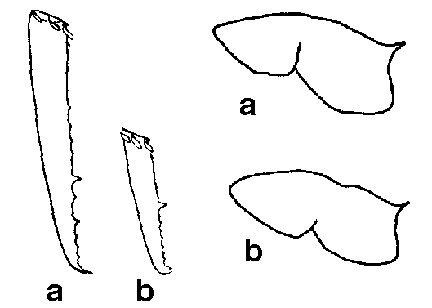
420a. Total head length greater than 0.90mm; eyes relatively large, with 24 or more ommatidia in total, with 6-7 in the longest row; scapes relatively long (SI 66-67): pasisops
420b. Total head length less than 0.90mm; eyes relatively smaller, with 14 or fewer ommatidia, with 2-4 in longest row; scapes relatively shorter (SI 48-61): 430
430a. Vertex with prominent transverse ridge: aethegenys
430b. Vertex lacking transverse ridge: 440
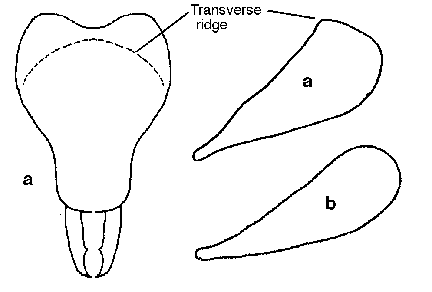
440a. Head in full-face view relatively narrow, CI 66-71; in profile head strongly dorsoventrally flattened, the maximum depth of the head capsule 0.35-0.41 x head length; color light yellow-brown; pair of mesonotal setae short and inconspicuous, tilted rearward: zeteki
440b. Head in full-face view relatively broad, CI 74-81; in profile head not strongly dorsoventrally flattened, the maximum depth of the head capsule 0.45-0.52 x head length; color red-brown to dark brown; pair of mesonotal setae conspicuous, often erect or tilted forward: 445

445a. Erect hairs on first gastral tergite remiform or markedly flattened and expanded apically; backcurved pair of stout hairs located posteriorly on petiole dorsum thickly remiform; scape relatively longer, SI 53-60: 450
445b. Erect hairs on first gastral tergite simple, acute or blunt apicaly but not remiform nor flattened and expanded apically; backcurved pair of stout hairs located posteriorly on petiole dorsum slender, scarcely thicker apically than basally; scape relatively shorter, SI 48-52: crementa
450a. Total head length less than 0.72mm; color light brown; mesonotal setae usually spatulate: brevicornis (light form)
450b. Total head length greater than 0.75mm; color red-brown to dark brown; mesonotal setae often relatively more filiform: brevicornis (dark form)

500a. Outer margins of mandibles relatively bowed; head length 0.75; mandibles relatively long (MI 67): lalassa
500b. Outer margins of mandibles relatively straight; head length less than 0.70mm; mandibles relatively shorter (MI 60 or less): 550
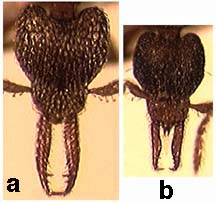
550a. Mandibles short and thick (MI less than 58), with inner margin convex; robust species, worker HL mostly greater than 0.48mm: 555
550b. Mandibles longer and slender (MI 56 or more), with inner margin relatively straight; smaller species, worker HL mostly 0.48 or less: 570
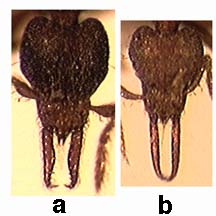
555a. Ground pilosity of head nearly or quite obsolete; color usually dark brown; mandible with exactly 3 small preapical teeth; erect setae on gastral dorsum filiform: trieces
555b. Ground pilosity abundant and conspicuous on head; color usually light brown to orange; mandible dentition various; erect setae on gastral dorsum remiform, swollen at the tip: 560
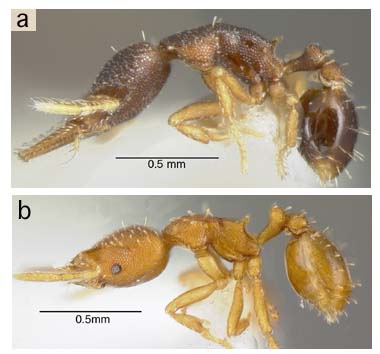
560a. Mandible with only tiny preapical denticles or one relatively larger preapical tooth followed by tiny denticles; metanotal groove not impressed; size relatively smaller, HL less than 0.6mm: 565
560b. Mandible with 2 or more relatively large preapical teeth; metanotal groove slightly impressed; size relatively large, HL about 0.69mm: 567

565a. Promesonotum with a single pair of standing setae (in addition to those at humeri), on mesonotum; setae projecting from leading border of scape relatively thin and strongly curved; first gastral tergite relatively less sculptured, with variable extent of longitudinal striolation on basal fourth or less; first gastral sternite largely smooth and shining; katepisternum smooth and shining: oconitrilloae
565b. Promesonotum with 4-6 pairs of stout remiform standing setae (in addition to those at humeri); setae projecting from leading border of scape broadly fan-shaped, less strongly curved; first gastral tergite relatively more sculptured, basal fourth or more striatopunctate; first gastral sternite finely reticulate to reticulate-punctate at least basally; katepisternum punctate: subedentata
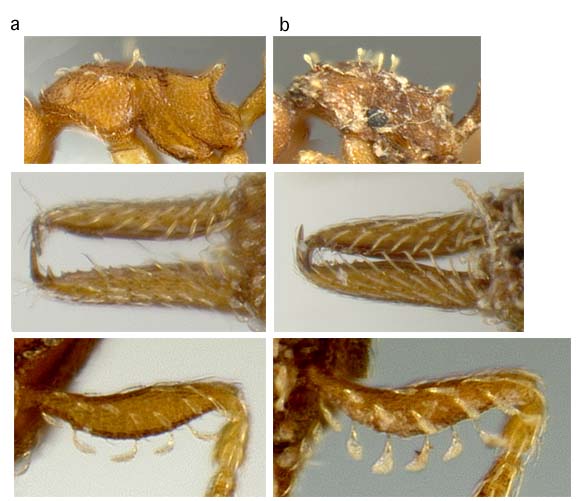
567a. Mandible with exactly 2 small preapical teeth and no denticles; katepisternum and part of side of propodeum smooth and shining; MeL about 0.7 mm: paniaguae
567b. Mandible with 3 or more preapical teeth; only a portion of katepisternum smooth and shining, side of propodeum punctate; MeL about 0.6 mm: cascanteae
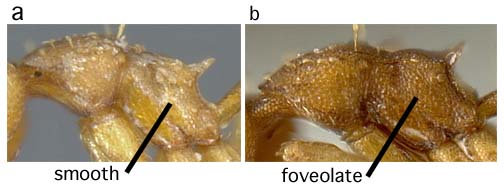
570a. Ventral spongiform appendages of postpetiole small but distinctly developed; gastral dorsum predominantly smooth and shining: gundlachi
570b. Ventral spongiform appendages of postpetiole absent; gastral dorsum with fine, mostly opaque reticulation: eggersi
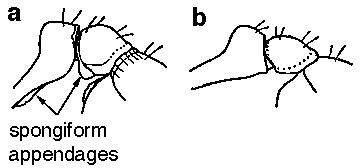
Page author:
John T. Longino, The Evergreen State College, Olympia WA 98505 USA.longinoj@evergreen.edu